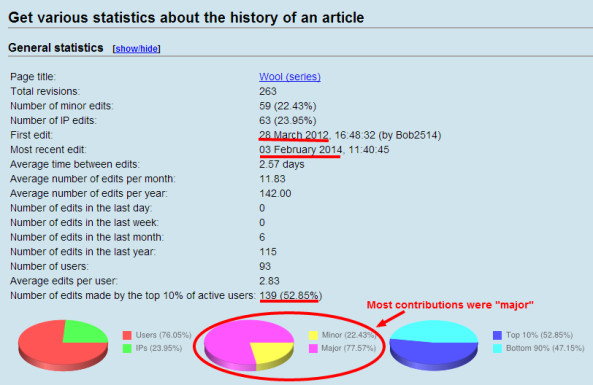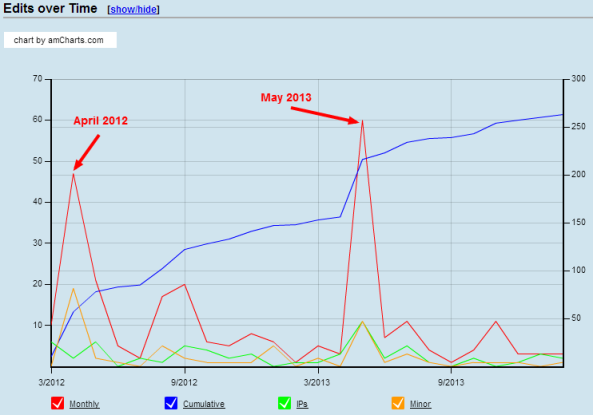In 2011, author Hugh Howey released the first novella in what would become the Wool series; a postapocalyptic sci-fi series that has become something of a case study for the success of self-publishing. With the series gaining mounting success over the last three years, being on the The New York Times e-book list for two weeks and selling over half a million copies, it is interesting to examine the series’ Wikipedia page and see in what way this popularity is reflected in the content of the page (Randall; Alter).
A look at the Wool (series) Wikipedia page shows a simple, if rather cursory, summary of each book. The summaries, while terse, are accurate (barring some spelling inconsistencies, like the hyphen usage in “Silo-18” and “Silo 17”) and display a quick and restrained approach to plot summary. The title of each book does not include direct subtitles, simply calling each book in the series “Book” followed by a number. The infobox to the right of the page displays basic information about the book in conformance to the WikiProject Novels format. A look in the talk page shows that the article has been added as part of WikiProject Novels and WikiProject Science Fiction:
 The existence of WikiProjects is a good example of what Henry Jenkins notes in his article “What Wikipedia Can Teach Us About New Media Literacies” when he mentions that “practices have emerged around Wikipedia as the community has sought to flag problems to be addressed and identify people with the skills and knowledge needed to solve them” (Jenkins). The WikiProject is one such practice that allows for consistency across articles and for communities to form towards common purposes. This very concept of “the ability to pool knowledge and compare notes with others towards a common goal” is in fact precisely the definition of collective intelligence.
The existence of WikiProjects is a good example of what Henry Jenkins notes in his article “What Wikipedia Can Teach Us About New Media Literacies” when he mentions that “practices have emerged around Wikipedia as the community has sought to flag problems to be addressed and identify people with the skills and knowledge needed to solve them” (Jenkins). The WikiProject is one such practice that allows for consistency across articles and for communities to form towards common purposes. This very concept of “the ability to pool knowledge and compare notes with others towards a common goal” is in fact precisely the definition of collective intelligence.
On the Wool page, there were 93 contributors and 263 revisions, 77% of which were considered major revisions. A small 10% of users were responsible for about half of all edits on the page, showing that the content of the page is influenced by the voice of a few users.
 Looking at the edit chart shows how the page has been shaped over time, and there are two major spikes coinciding with certain events involving the Wool series. The first spike in April 2012 occurred a month after the article was created (by a fan), and the author Hugh Howey himself encouraged other fans to edit the page on his blog. This is what perhaps led to an individual in the talk page claiming the article “Reads like [an] advertisement.”
Looking at the edit chart shows how the page has been shaped over time, and there are two major spikes coinciding with certain events involving the Wool series. The first spike in April 2012 occurred a month after the article was created (by a fan), and the author Hugh Howey himself encouraged other fans to edit the page on his blog. This is what perhaps led to an individual in the talk page claiming the article “Reads like [an] advertisement.”
The second spike was in May 2013 when Amazon first revealed their fan fiction site “Kindle Worlds” (Amazon). While the Wool franchise was not a part of this initiative until June 2013, this inspired two users to add an entire section dedicated to Wool fan fiction (of which there was already an abundance) and speculation about Wool being a part of Kindle Worlds (Howey). This led to a brief edit war when another user removed this section, the original writer re-added it, and then it was finally removed after a section in the talk page was created addressing the issue.
This back an forth and final discussion is an important part of the process of collective intelligence. In the Henry Jenkins article, he quotes Peter Walsh who says: “Debates about rules are part of the process by which knowledge gets generated” (qtd. in Jenkins). The above is an example of one such debate, and it shows that even an article with a small number of contributors can still exhibit collective intelligence through organized disagreement and debate.
In summary, the article for the Wool series is an interesting case study for collective intelligence on Wikipedia for an article with a relatively small number of contributors. Indeed, the article is lacking in substantive information about the series, which is why one must approach Wikipedia with “informed skepticism” and the knowledge that the page may not render the topic in its entirety (Jenkins).
Works Cited:
Alter, Alexandra. “Sci-Fi’s Underground Hit.” The Wall Street Journal. Dow Jones & Company, 14 Mar. 2013. Web. 16 Feb. 2014. <http://online.wsj.com/news/articles/SB10001424127887324678604578340752088305668>.
Amazon. Amazon Media Room. Amazon Publishing Introduces “Kindle Worlds”Amazon Media Room. Amazon, 22 May 2013. Web. 16 Feb. 2014.
Howey, Hugh. “Where Words Become Worlds.” Hugh Howey. N.p., 19 June 2013. Web. 16 Feb. 2014. <http://www.hughhowey.com/where-words-become-worlds>.
Jenkins, Henry. “What Wikipedia Can Teach Us About New Media Literacies.”Confessions of an AcaFan. N.p., 27 June 2007. Web. 16 Feb. 2014. <http://henryjenkins.org/2007/06/what_wikipedia_can_teach_us_ab_1.html>.
Randall, Rachel. “How Hugh Howey Turned His Self-Published Story “Wool” Into a Success (& a Book Deal).” Writer’s Digest. N.p., n.d. Web. 23 Jan. 2014.


Great job providing the reader with enough background information on Wool that they have a clear enough grasp of the topic to follow your analysis. Introducing Jenkins and the title of his work early in the post provides the reader with terminology and context that helps them understand the way Jenkins connects to your main points. The annotations in the images and the textual description/analysis of the images in your post adds useful visual evidence for your argument. Great job using in-text citations to clearly show what information is original to your blog post and what comes from external sources. Also, good job working links into the text of your post to make them reader-friendly. The blog provides a great analysis of the statistics of the Wikipedia page with the context of collective intelligence, leaving your reader with a clear sense of your main points.